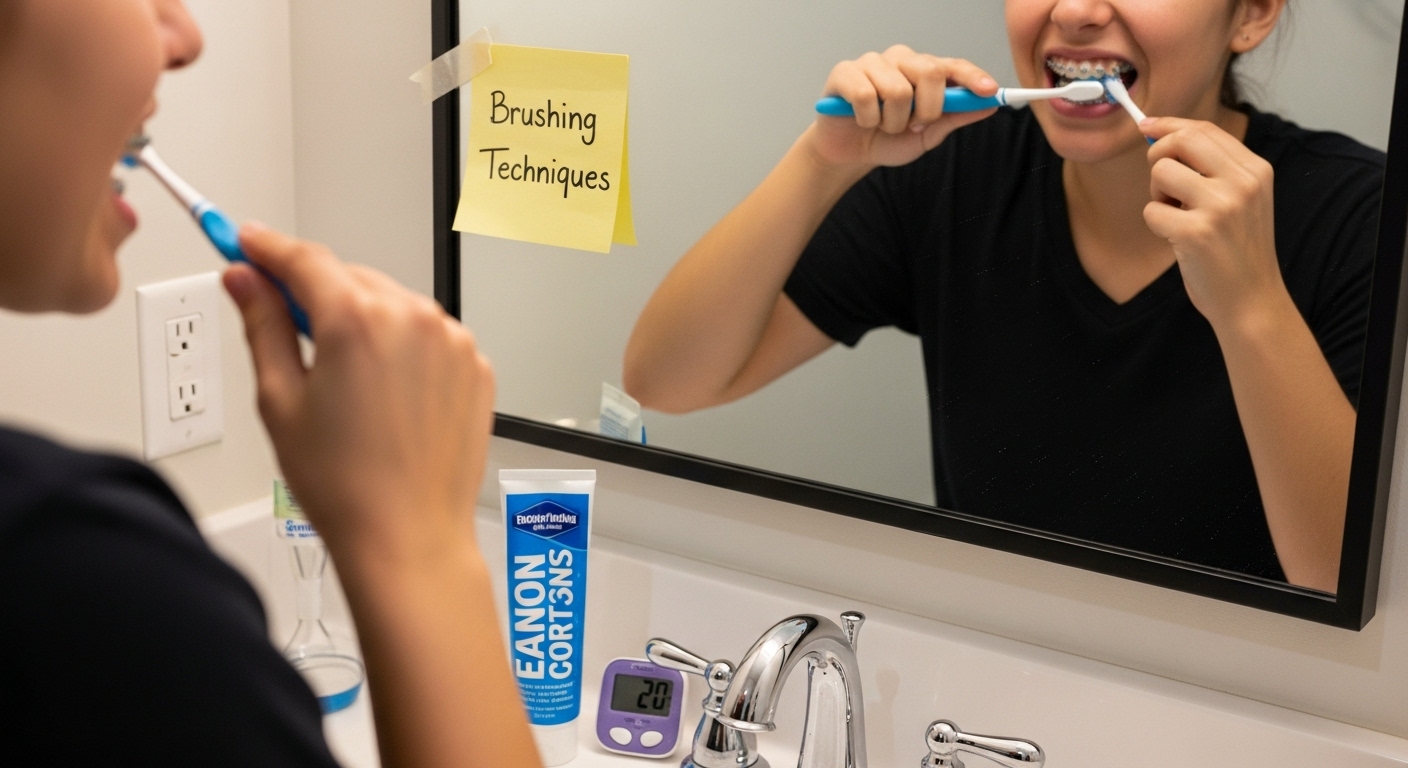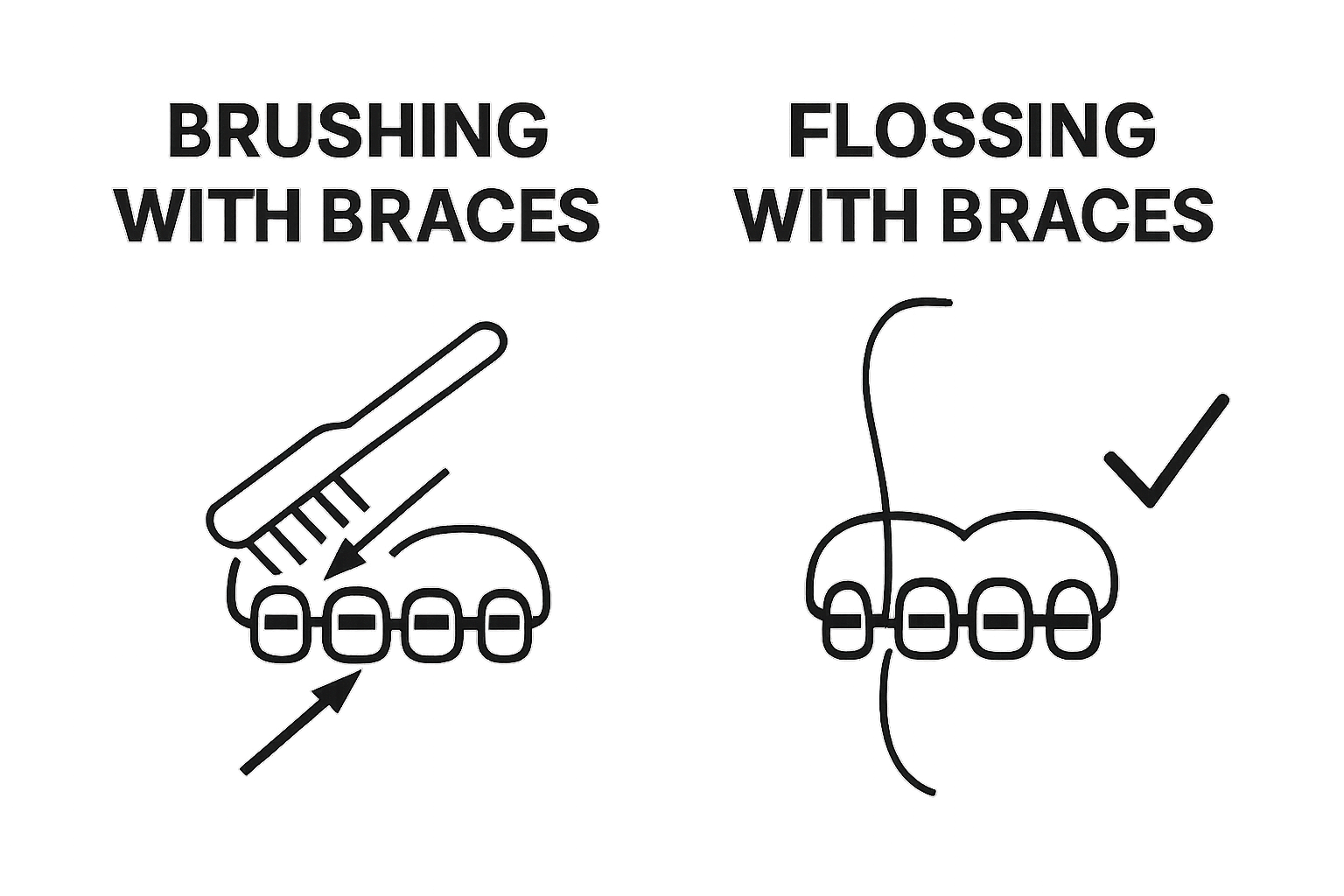How to Avoid Cavities with Braces: Essential Steps for Success
September 15, 2025
How to Avoid Cavities with Braces: Essential Steps for Success
Braces can seem like a fortress for your teeth, but they also turn everyday oral care into a real challenge. The surprising part is that even with daily brushing, people with braces are more likely to develop cavities than those without. Most assume braces just straighten teeth, but protecting your smile during treatment takes a lot more than adjustments and appointments.
Table of Contents
- Step 1: Schedule Regular Orthodontic Appointments
- Step 2: Master Proper Brushing Techniques
- Step 3: Implement A Daily Flossing Routine
- Step 4: Choose Orthodontic-Friendly Foods
- Step 5: Use Fluoride Mouthwash For Extra Protection
- Step 6: Monitor Oral Health Regularly
Quick Summary
| Key Point | Explanation |
|---|---|
| 1. Schedule Regular Orthodontic Appointments | Consistent appointments are crucial for monitoring your dental health and preventing cavities during orthodontic treatment. |
| 2. Master Proper Brushing Techniques | Utilize an orthodontic-specific toothbrush and dedicate time to clean around brackets effectively, targeting all angles. |
| 3. Implement a Daily Flossing Routine | Use specialized tools like floss threaders to ensure thorough cleaning between teeth and braces. |
| 4. Choose Orthodontic-Friendly Foods | Opt for soft, easy-to-chew foods that minimize the risk of damaging braces and support cavity prevention. |
| 5. Use Fluoride Mouthwash for Extra Protection | Rinsing with fluoride mouthwash strengthens enamel and helps protect against tooth decay in hard-to-reach areas. |
Step 1: Schedule Regular Orthodontic Appointments
Managing cavity prevention with braces requires a proactive approach, and scheduling regular orthodontic appointments is your foundational strategy. These checkups are not just routine visits but critical interventions that protect your dental health and ensure your orthodontic treatment progresses smoothly.
Your orthodontic appointments serve multiple essential purposes beyond adjusting braces. During these visits, professionals conduct comprehensive examinations that target potential cavity risks specific to patients wearing orthodontic hardware. Professional cleanings around braces are especially crucial, as traditional brushing and flossing become more challenging with brackets and wires.
According to research published in the Journal of International Society of Preventive & Community Dentistry, frequent orthodontic follow-ups significantly reduce the likelihood of developing dental caries. These appointments allow specialists to:
- Professionally clean hard-to-reach areas around orthodontic brackets
- Identify early signs of potential tooth decay
- Apply targeted preventive treatments like fluoride
- Make necessary adjustments to your braces
Typically, orthodontic appointments should occur every 4-8 weeks, depending on your specific treatment plan. Your orthodontist will recommend a personalized schedule based on your unique dental structure and treatment progress. During these visits, expect a thorough examination that includes checking wire tension, assessing bracket placement, and evaluating overall oral hygiene.
To maximize the effectiveness of these appointments, arrive prepared with questions about your oral care routine. Discuss any challenges you are experiencing with cleaning around braces and request specific guidance. Many orthodontic offices offer specialized tools and demonstrations to help patients maintain optimal dental hygiene throughout their treatment.
Remember that consistent appointments are not just about maintaining your braces but protecting your long-term dental health. By prioritizing these regular check-ups, you create a proactive defense against potential cavities and ensure your orthodontic journey remains on track.
Step 2: Master Proper Brushing Techniques
Brushing with braces requires a completely different approach compared to standard dental hygiene. The intricate network of brackets, wires, and bands creates numerous tiny spaces where food particles and bacteria can accumulate, making meticulous cleaning techniques absolutely critical for preventing cavities.
Specialized brushing becomes your primary defense against dental decay. Traditional brushing methods simply will not suffice when you have orthodontic hardware. You will need to develop a methodical, precise approach that reaches every nook and cranny around your braces.
According to research from the American Journal of Orthodontics, patients with braces need to invest significantly more time and attention to their oral hygiene routine. Experts recommend using an orthodontic-specific toothbrush with bristles designed to navigate around brackets and wires.
Your brushing technique should follow a systematic process. Start by rinsing your mouth with water to loosen food particles. Hold your toothbrush at a 45-degree angle to the gums, using gentle circular motions. Spend at least 2-3 minutes brushing, focusing on cleaning above and below each bracket. Move your brush in multiple directions: horizontally across brackets, vertically along wire lines, and at diagonal angles to ensure comprehensive coverage.
Consider investing in additional tools to enhance your cleaning routine:
- Orthodontic-specific soft-bristled toothbrushes
- Interdental brushes for tight spaces
- Water flossers for hard-to-reach areas
Pay extra attention to areas where brackets meet teeth, as these regions are most susceptible to plaque buildup and potential cavity formation. Use a fluoride toothpaste and apply gentle pressure to avoid damaging your braces.
 Electric toothbrushes with orthodontic brush heads can also provide more consistent and thorough cleaning.
Electric toothbrushes with orthodontic brush heads can also provide more consistent and thorough cleaning.
Verify your technique by checking for visible food particles after brushing. A clean set of braces should appear shiny and free from debris.
 If you notice persistent buildup or difficulty reaching certain areas, consult your orthodontist for personalized guidance and potentially demonstrate your brushing technique during your next appointment.
If you notice persistent buildup or difficulty reaching certain areas, consult your orthodontist for personalized guidance and potentially demonstrate your brushing technique during your next appointment.
Step 3: Implement a Daily Flossing Routine
Flossing with braces presents unique challenges that require specialized techniques and patience. While many people struggle with flossing under normal circumstances, orthodontic hardware adds an extra layer of complexity that demands precise and consistent approach.
Flossing becomes even more critical when you have braces, as food particles and plaque can easily become trapped in the intricate spaces between brackets and wires. Traditional flossing methods simply will not work effectively, necessitating specialized tools and techniques to maintain optimal oral hygiene.
According to Nationwide Children’s Hospital, navigating floss around orthodontic hardware requires specific tools and strategies. A floss threader becomes your primary instrument for success, allowing you to maneuver dental floss underneath the main archwire and between teeth.
Begin your flossing routine by threading a piece of waxed floss through the plastic loop of a floss threader. Carefully guide this threader under the main wire, then gently move the floss up and down along the sides of each tooth. Take your time and be gentle to avoid damaging your braces or causing discomfort. Work systematically, moving from one tooth to the next, ensuring you clean both sides of each tooth.
Consider incorporating these additional tools to enhance your flossing effectiveness:
- Orthodontic-specific floss threaders
- Waxed dental floss
- Water flossers with orthodontic tips
- Interdental brushes for wider spaces
Many patients find water flossers particularly helpful, as these devices can blast away food particles and plaque from hard-to-reach areas around brackets. They provide a gentler alternative for those who find traditional flossing challenging or uncomfortable.
Verify your flossing technique by checking for any remaining food particles after completing your routine. Your goal is a clean mouth where no visible debris remains between teeth or around brackets. If you consistently struggle with flossing, do not hesitate to ask your orthodontist for a personalized demonstration during your next appointment.
The following table summarizes essential tools and products recommended throughout the article for effective oral care with braces, identifying their purpose and best usage scenario.
| Tool/Product | Purpose | Best Usage Scenario |
|---|---|---|
| Orthodontic Toothbrush | Cleans around brackets and wires | Daily brushing routine |
| Interdental Brush | Cleans tight and hard-to-reach spaces | Use after meals to dislodge debris |
| Water Flosser | Removes plaque and food particles between teeth and around braces | Supplement to flossing, daily use |
| Floss Threader | Threads floss under the archwire | Essential for nightly flossing |
| Waxed Dental Floss | Prevents fraying and snags on braces | Daily manual flossing with threaders |
| Fluoride Mouthwash | Strengthens enamel and protects against cavities | Rinse after brushing and flossing, twice daily |
| Dental Mirror | Enables self-examination of teeth and braces | Weekly monitoring at home |
Step 4: Choose Orthodontic-Friendly Foods
Diet plays a crucial role in maintaining dental health during orthodontic treatment. The foods you choose can either protect or potentially damage your braces while significantly impacting your cavity prevention strategy. Your dietary choices become a powerful tool in preserving both your orthodontic hardware and overall dental wellness.
Navigating food selection requires understanding how different textures and compositions interact with braces. Hard, sticky, and overly chewy foods pose the greatest risk to your orthodontic investment. These items can potentially break brackets, bend wires, and create additional spaces where harmful bacteria can accumulate, increasing your cavity risk.
According to the American Association of Orthodontists, patients with braces should focus on soft, easily chewable foods that minimize stress on orthodontic hardware. Opt for nutrient-rich options that support dental health while being gentle on your braces.
Soft proteins become your best nutritional allies. Think scrambled eggs, tender fish, ground meats, and soft-cooked chicken. These foods provide essential nutrients without requiring excessive force to chew. Dairy products like yogurt, soft cheeses, and smoothies offer calcium and protein while being bracket-friendly. Cooked vegetables, mashed potatoes, and steamed rice provide balanced nutrition without risking damage to your orthodontic appliances.
Consider incorporating these cavity-fighting, braces-friendly food options:
- Soft fruits like bananas, berries, and ripe melon
- Protein-rich smoothies
- Oatmeal and other soft grains
- Scrambled eggs and soft-cooked proteins
- Yogurt and pudding
Avoid foods that pose significant risks to your braces and dental health. Hard candies, nuts, popcorn, chewy candies, and tough meats can break brackets or get lodged in challenging areas. Cut harder fruits and vegetables into small, manageable pieces to prevent potential damage. When eating apples or carrots, slice them into thin strips rather than biting directly.
Verify your dietary choices by checking your braces after meals. No food particles should remain trapped around brackets, and your hardware should feel intact. If you consistently struggle with food getting stuck, consider carrying a small orthodontic care kit with interdental brushes or a water flosser to clean immediately after eating.
Step 5: Use Fluoride Mouthwash for Extra Protection
Fluoride mouthwash represents a critical defense mechanism in your cavity prevention strategy, especially when wearing braces. These specialized rinses provide an additional layer of protection that standard oral hygiene routines cannot achieve alone. Braces create numerous microscopic spaces where bacteria can accumulate, making traditional cleaning methods less effective.
With orthodontic hardware, your teeth become more vulnerable to demineralization and potential decay. Fluoride mouthwash acts as a protective shield, strengthening tooth enamel and creating a robust barrier against harmful bacteria that might exploit the complex spaces around your brackets and wires.
According to research published in the National Institutes of Health, topical fluoride applications significantly reduce the risk of dental caries during orthodontic treatment. The concentrated fluoride formulation helps remineralize tooth surfaces, effectively combating the increased cavity risk associated with braces.
When selecting a fluoride mouthwash, prioritize alcohol-free formulations designed specifically for orthodontic patients. These versions provide maximum protection without causing dry mouth or irritation. Rinse thoroughly but gently, ensuring the liquid reaches all areas around your braces. Tilt your head back slightly and swish the mouthwash for 30-60 seconds, allowing the fluoride to coat every surface of your mouth.
Consider these guidelines for optimal fluoride mouthwash usage:
- Choose an orthodontist-recommended fluoride rinse
- Rinse after brushing and flossing
- Use consistently, ideally twice daily
- Avoid eating or drinking for 30 minutes after rinsing
Timing matters when incorporating fluoride mouthwash into your routine. The best practice involves using it after your thorough brushing and flossing regimen. This sequence ensures that food particles are first removed, allowing the fluoride to make direct contact with tooth surfaces and orthodontic hardware.
Verify the effectiveness of your fluoride mouthwash routine by monitoring your oral health during orthodontic appointments. Your orthodontist can assess enamel strength and identify any early signs of potential decay. Pay attention to how your mouth feels after rinsing – a clean, refreshed sensation indicates proper technique and coverage.
Step 6: Monitor Oral Health Regularly
Monitoring your oral health during orthodontic treatment requires a proactive and vigilant approach. Your mouth becomes a complex ecosystem that demands consistent attention and professional oversight. Braces create unique challenges that can quickly transform minor issues into significant dental complications if left unchecked.
Regular monitoring goes beyond standard dental checkups. You will need to develop a comprehensive strategy that combines professional evaluations with personal observations. This approach allows you to catch potential problems early, preventing minor concerns from escalating into more serious dental issues that could compromise your orthodontic treatment.
According to the American Dental Association, patients with braces should have more frequent professional evaluations compared to individuals without orthodontic hardware. These check-ups provide an opportunity for detailed assessments of your teeth, gums, and overall oral health.
Establish a routine that includes both professional and personal monitoring techniques. Schedule dental check-ups every three to four months, ensuring your orthodontist can track your treatment progress and identify any emerging cavity risks. During these appointments, expect comprehensive examinations that include detailed inspections of your brackets, wires, and tooth surfaces.
Develop a personal monitoring protocol that complements professional evaluations:
- Conduct weekly self-examinations in good lighting
- Check for visible changes in tooth color or texture
- Look for white spots or discoloration around brackets
- Monitor gum health and potential inflammation
- Track any unusual sensitivity or discomfort
Invest in tools that support thorough home monitoring. A good dental mirror, bright lighting, and possibly a small handheld camera can help you document and track changes in your oral health. Take periodic photographs of your teeth to create a visual record that can help you and your orthodontist identify subtle changes over time.
Verify the effectiveness of your monitoring by maintaining a detailed oral health journal. Record observations, document any concerns, and track your oral hygiene routine. This proactive approach transforms you from a passive patient into an active participant in your dental health journey, ensuring comprehensive protection against potential cavity risks during your orthodontic treatment.
The table below presents a checklist you can use at home to monitor and verify your oral health while wearing braces, helping you address concerns and track changes effectively.
| Monitoring Step | What to Check For | Frequency |
|---|---|---|
| Self-Examination | White spots, discoloration, or plaque around brackets | Weekly |
| Gum Health Assessment | Redness, swelling, or bleeding of gums | Weekly |
| Sensitivity Check | Sudden discomfort or sensitivity in teeth or gums | As needed |
| Bracket & Wire Inspection | Broken brackets or loose wires | After each meal and weekly |
| Photo Documentation | Noticeable changes in teeth alignment or surface | Monthly |
| Oral Health Journal | Track routines and any issues noticed | Weekly |
Ready to Protect Your Smile with Expert Orthodontic Care?
Are you struggling to keep cavities at bay while managing the daily challenges of brushing and flossing around braces? The steps in this article highlight how difficult it can be to maintain good oral hygiene when brackets and wires get in the way. You want peace of mind knowing your orthodontic journey will not be interrupted by dental problems. At Glow Orthodontics, we understand the unique challenges of cavity prevention with braces. Our team uses proactive checkups, personalized cleaning tips, and advanced prevention tools to help you succeed at every stage of your orthodontic treatment.

Your oral health deserves the highest level of care and expertise. Experience a welcoming office environment, flexible appointment booking, and guidance tailored to your needs. Start your journey toward a healthy, cavity-free smile today by visiting our homepage to schedule your consultation or explore our commitment to patient-centered orthodontics in Langley. Do not wait for small issues to become big problems. Take charge now and see how our solutions support every essential step outlined in this article.
Frequently Asked Questions
How often should I schedule orthodontic appointments while wearing braces?
Typically, orthodontic appointments should occur every 4-8 weeks, depending on your treatment plan, to monitor progress and prevent cavities.
What tooth brushing technique is best for cleaning teeth with braces?
Hold your toothbrush at a 45-degree angle to your gums, using gentle circular motions and spending at least 2-3 minutes focusing on cleaning above and below each bracket.
What foods should I avoid to prevent damage to my braces and cavities?
Avoid hard, sticky, and chewy foods like hard candies, popcorn, and gum. Opt for softer foods such as cooked vegetables, tender meats, and yogurt to protect your braces.
How can fluoride mouthwash help maintain oral health with braces?
Fluoride mouthwash strengthens tooth enamel and helps remineralize teeth, effectively reducing the risk of cavities that can develop around brackets and wires.